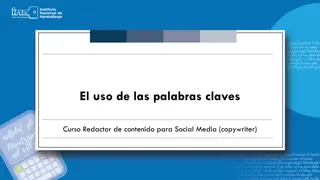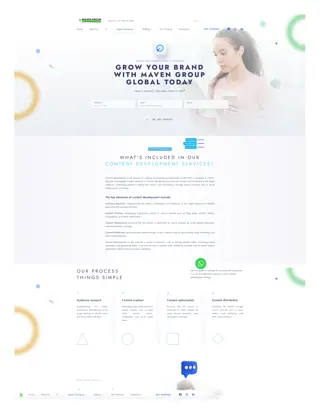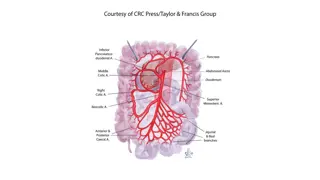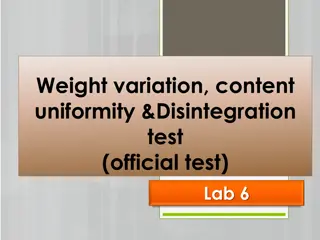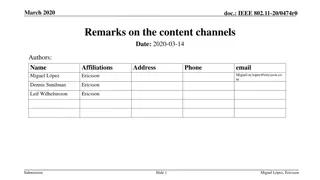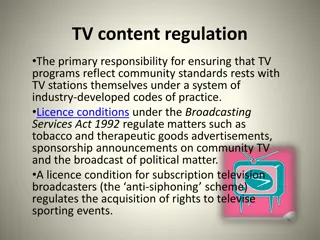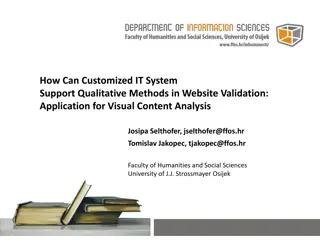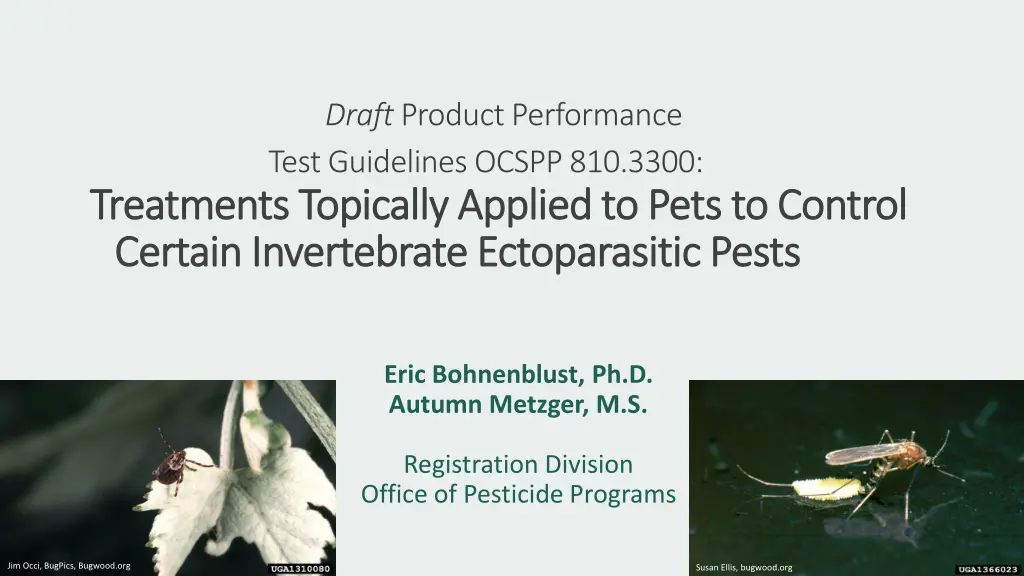
Guidelines for Testing Pet Parasite Treatments: OCSPP 810.3300
These guidelines provide recommendations for testing pesticide products applied to pets to control invertebrate ectoparasitic pests. The document outlines the purpose, protocol elements, specific testing guidance, and organizational structure of the guideline. It covers testing against fleas, ticks, mosquitoes, and biting flies, supporting pesticide product registration under FIFRA.
Download Presentation

Please find below an Image/Link to download the presentation.
The content on the website is provided AS IS for your information and personal use only. It may not be sold, licensed, or shared on other websites without obtaining consent from the author. If you encounter any issues during the download, it is possible that the publisher has removed the file from their server.
You are allowed to download the files provided on this website for personal or commercial use, subject to the condition that they are used lawfully. All files are the property of their respective owners.
The content on the website is provided AS IS for your information and personal use only. It may not be sold, licensed, or shared on other websites without obtaining consent from the author.
E N D
Presentation Transcript
Draft Product Performance Test Guidelines OCSPP 810.3300: Treatments Topically Applied to Pets to Control Treatments Topically Applied to Pets to Control Certain Invertebrate Ectoparasitic Pests Certain Invertebrate Ectoparasitic Pests Eric Bohnenblust, Ph.D. Autumn Metzger, M.S. Registration Division Office of Pesticide Programs 1 Jim Occi, BugPics, Bugwood.org Susan Ellis, bugwood.org
Outline of Presentation Draft guideline purpose and scope Protocol elements, testing, and completed study reporting Review of specific guidance for testing pesticide products; sections (j) through (n) 2
Introduction (a) Scope/Purpose Provide recommendations for the design and execution of laboratory methods to evaluate product performance of pesticides applied to pets against fleas, ticks, mosquitoes, and biting flies Support registration of pesticide products under FIFRA 3 3
Organization of the Guideline (b) 10 (a) Introduction; (b) Organization of the guideline; (c) Definitions; (d) Development of protocols for efficacy studies; (e) Review of protocols for efficacy studies; (f) Execution of efficacy studies; (g) Reporting of completed efficacy studies to the agency; (h) Retention of records; (i) Methods applicable to all tested pests; 4
Organization of the Guideline (b) Cont. 1 2 (j) Specific guidance for laboratory testing of topically applied products for the treatment and prevention of flea infestations (all product types except insecticidal shampoos); (k) Specific guidance for laboratory testing of topically applied products for the treatment and prevention of tick infestations (all product types except insecticidal shampoos); (l) Specific guidance for laboratory testing of topically applied products for efficacy against mosquitoes and biting flies (all product types except insecticidal shampoos); (m) Specific guidance for evaluating efficacy of insecticidal shampoo products (not including dry shampoos or dusts); (n) Specific guidance for evaluating efficacy under simulated environmental conditions; (o) References. 5
Definitions (c) Lowest labeled dose refers to the lowest pesticide application rate to be applied to any pet per the label instructions. If a product is labeled for dosing by weight class (e.g., apply 0.34 fl. oz. tube of product to dogs weighing between 7 and 14 lb), the lowest labeled dose is the label dose (0.34 fl. oz.) divided by the maximum weight pet within the weight class (14 lb). Example: Label directions: apply 0.34 fl. oz. tube of product to dogs 7-14 lb. Lowest dose = 0.34 fl. oz./14 lb dog = 0.0243 fl. oz./lb. All treated dogs in study would be dosed with 0.0243 fl. oz./lb. If there are multiple weight brackets, choose the most conservative dose of all brackets. Exception: collars 8 6
Development of Protocols (d): Scientific Design Objectives Products to be tested in a manner that reflects intended labeled use (e.g., appropriate life stage and application method) and will provide data to support product performance. Test materials and treatments Use end-use product, except for testing insect growth regulators (IGR). When testing IGRs, only IGR active ingredients (a.i.) are tested with diluent (no adulticide in tested product). Dose determination Use lowest labeled dose, referred to in mg/kg, oz/lb, etc. 7
Development of Protocols (d): Scientific Design Selection and allocation of animals Animalsare qualified, blocked and randomly allocated to treatment and control groups based on attractiveness to the pest species or group of species used for testing. Housing of test animals Animals are housed in individual cages during period(s) of infestation. For other time periods, animals may be housed together by species (but separated by treatment groups). Housing conditions meet or exceed GLP requirements outlined in 40 CFR 160.90, related to animal welfare. Temperature, relative humidity, and ambient light and photoperiod are reported as well as the amount and type of food provided. Animals are provided with water ad libitum. 8
Development of Protocols (d): Scientific Design Choice of endpoints Chosen for the specific objectives of the proposed research Examples: Knockdown, mortality and repellency Additional information on choosing endpoints for testing specific pests or claims in specific study sections (i) through (n) Test organisms Appropriatepest species or group of species From laboratory colonies & certified free of disease-causing pathogens Testing of up to 2 species simultaneously for fleas and ticks 7 9
Development of Protocols (d): Scientific Design Representative sampling Replication: Sample size justified using an analysis of power vs. sample size. Negative control: In all studies, include an untreated control, except in studies testing a shampoo product. The number of negative control replicates equal the number of replicates for each treatment. Controls are treated in a similar manner. For testing insecticidal shampoo products, a non- pesticidal/non-medicated shampoo is used as a control. Positive control: To reduce the number of animals used during testing, positive controls are not used. Quality Assurance/Quality Control plan Protocols will provide for periodic quality assurance inspections to ensure the integrity of the study and consistency with the provisions of EPA s GLP regulations (40 CFR 160). 10
Development of Protocols (d): Analyzing Data Study protocols include descriptions and explanations of the statistical methods used to analyze results of product performance tests. Estimate and report efficacy and 95% confidence interval(CI) of the treatment 9a Study protocols explicitly describe the statistical model to be used and demonstrate whether or not assumptions underlying the model can be met for all proposed analyses. Generalized linear models (GLMs) or generalized linear mixed-models (GLMM) are recommended for non-normal data using an appropriate link function. Analysis of variance (ANOVA) or mixed-effects models can be used if their assumptions, such as normality, are justified. Photo courtesy of http://maxpixel.freegreatpicture.com/Business- Arrows-Statistics-Economy-Finance-Trend-2899893 Restrictions on randomization of any testing components are documented clearly and accounted for correctly in the statistical analyses. A statistician may be consulted. 11
Issues with Current Studies & Sample Size Historically EPA has received studies using 2-12 animals per treatment group. No statistical basis for historical sample sizes Many studies have been rejected for issues including inadequate sample size or inadequate control animals This requires multiple studies to be run and thereby utilizes more animals over the course of multiple studies. This draft guideline and simulations to develop recommended sample sizes, as well as other parameters included in the simulations, will reduce the number of rejected studies, thereby reducing the amount of animals tested by eliminating redundant testing and producing stronger, more reliable results. In addition, we are asking that studies do not run positive controls anymore, which was encouraged in the previous guideline version. This will reduce the number of animals used for testing. EPA is in active discussions with animal welfare NGOs to consider methods of reducing animal testing 12
Sample Size and Statistical Analyses To determine the resulting power of different study designs, EPA statisticians conducted simulations using submitted studies. Based on the simulations for sections (j)- (l) found in Appendix 1, EPA determined the sample size which results in 80% power to observe efficacy of 90% with a precision of 5% when the true efficacy of the product is 92.5% with specific assumptions about the pest retention/blood feeding rate in the control group and distributions of random effects of animals or days. 9b 9c 13
Sample Size and Statistical Analyses Sample size (per treatment group) Study design Relevant section of guideline 1 Ticks on cats or dogs, (k)(2) 14 4 3 Fleas on cats, (j)(2) 7 4 Mosquitoes or flies on cats or dogs using 50 pests, (l)(2) 8 Fleas on dogs, (j)(2) Mosquitoes or flies for cats and dogs using 100 pests, (l)(2) 5 6 14
Review of Protocols for Efficacy Studies (e) Revised guideline discusses testing methodology for common product performance tests and may not cover novel products or modes of action. EPA recommends protocols proposing novel testing methods be submitted to EPA for review before the study begins to ensure that the testing methodology will be acceptable. 15
Execution of Efficacy Studies (f) Execution of protocol Initiate tests incorporating EPA comments after EPA review of protocol is complete. Protocol amendments Make planned changes to the protocol before the study is executed and note all amendments to the protocol in the written report to the agency. Report deviations from protocol that may occur (40 CFR 160.185). Quality Assurance (QA) oversight Product performance testing is subject to GLP regulations at 40 CFR 160. 16
Reporting of Completed Efficacy Studies to the Agency (g) Study identification Study objectives Testing conditions Testing system Data/Results reporting Include raw data Study conclusions Photo courtesy of: https://pixabay.com/en/clipboard-green- check-list-311168/ 17
Topically applied flea products (except shampoos) (j) Testing for adult flea mortality and IGR effects using laboratory-reared catfleas Balanced study design: 7 cats per treated and untreated control group 6 dogs per treated and untreated control group 12 11 Animalsare qualified, blocked and randomly allocated to treatment and control groups based on attractiveness to fleas Treat on day zero with lowest labeled dose for each animal Infest with 100 adult fleas (50:50 male/female) over entire body, but not adjacent to treatment site (controls treated the same) Controls should retain at least 40% of fleas on cats and 60% of fleas on dogs throughout study 5a For IGR controls, at least 60% of fleas should emerge through the endpoint (egg hatch/adult emergence) 18
Topically applied flea products (except shampoos) (j) Schedule for exposing animals to fleas depending on the claimed duration of efficacy for the test substance. Claimed Duration of Efficacy Timing of infestations (treatment occurs on day 0) < 7 days Day -1, and the time corresponding to the longest labeled duration of efficacy 6 7 days to 4 weeks Days -1 and 7, then weekly up to the longest labeled duration of efficacy > 4 weeks Days -1, 7, 14, 21 & 28 or 30, then monthly up to the longest labeled duration of efficacy 19
Topically applied flea products (except shampoos) (j) Endpoint: Adult mortality Live flea counts on treated animals vs. live flea counts on control animals Data collection and recording Any initial counts (e.g., 8 hours, 12 hours, etc.) can be conducted using hand counts but final counts for each infestation/re-infestation are conducted via comb out. Count live, dead, or moribund individuals (moribund individuals are considered alive). The first count can be up to day 3 (72 hours after treatment) but re-infestation counts (e.g., the weekly challenges starting on day 7) are recorded by 48 hours post- infestation. To assess when a product starts killing (e.g., starts killing in 30 minutes ), dead fleas are counted and recorded both on the animal and in the tray/cage at the desired time post application (e.g., 30 minutes) and again at the same time after each re-infestation (e.g., day 7 at 30 min) and compared to controls. 20
Topically applied flea products (except shampoos) (j) Endpoint: Adult mortality Data analysis: Calculate the efficacy and its 95% confidence interval based on Abbott s formula at each time point. Efficacy = (control survival rate treatment survival rate)/control survival rate = 1 treatment survival rate/control survival rate = 1 treatment adjusted survival rate = adjusted mortality rate of treatment group 21
Topically applied flea products (except shampoos) (j) Endpoint: IGRs Typical endpoints are egg hatch and adult emergence. Data collection and recording Eggs are collected from the animal and trays underneath the animal, then moved to a clean container and incubated to determine hatching and/or adult emergence depending on label claims. Flea eggs may be collected on multiple occasions to ensure enough eggs are collected after each infestation, and adult fleas are combed out of the animal after egg collection is complete. Collected eggs (at least 50 per animal) can be divided into two groups to determine both larval hatch and adult emergence rates. 22
Topically applied flea products (except shampoos) (j) Endpoint: IGR Data analysis: Calculate the efficacy and its 95% confidence interval based on Abbott s formula at each time point. Efficacy = (control hatching rate treatment hatching rate)/control hatching rate = 1 treatment hatching rate/control hatching rate = 1 treatment adjusted hatching rate = adjusted mortality rate of treatment group 23
Topically applied tick products (except shampoos) (k) Testing for tick mortality and repellency with adults of at least the three representative species of ticks (If claims against other tick species are desired, those species may be tested in addition to the three representative species using the same methods (e.g., the gulf coast tick)). Balanced study design: 14 cats per treated and untreated control group 14 dogs per treated and untreated control group Animalsare qualified, blocked and randomly allocated to treatment and control groups based on attractiveness to ticks. Treat on day zero with lowest labeled dose for each animal. 5b Infest with 50 adult ticks (50:50 male/female) over entire body, but not adjacent to treatment site (controls treated the same). 13 Up to two tick species may be tested on the same animal simultaneously. Controls should retain a minimum of 25% of ticks throughout the study. 24
Topically applied tick products (except shampoos) (k) Endpoint: Adult mortality To keep ticks from escaping, use double sided sticky tape or petroleum jelly around cages and pans. Collection trays are kept beneath the animals between infestation and counts to account for pests that may fall off the animal. Schedule for exposing animals to ticks for mortality testing, depending on the claimed duration of efficacy for the test substance. Claimed Duration of Efficacy < 7 days Timing of infestations (treatment occurs on day 0) Day -1, and the time corresponding to the longest labeled duration of efficacy 7 days to 4 weeks Days -1 and 7, then weekly up to the longest labeled duration of efficacy > 4 weeks Days -1, 7, 14, 21 & 28 or 30, then monthly up to the longest labeled duration of efficacy 6 25
Topically applied tick products (except shampoos) (k) Endpoint: Adult mortality Determined by comparing dead, unengorged ticks on the animals and in trays/cages to the control group 14 Data collection and recording Any initial counts (e.g., 8 hours, 12 hours, etc.) can be conducted using hand counts but final counts for each infestation/re-infestation are conducted via comb out. Count live, dead, or moribund individuals (moribund individuals are considered alive). The first count can be up to day 3 (72 hours after treatment) but re-infestation counts (e.g., the weekly challenges starting on day 7) are recorded by 48 hours post-infestation. To assess when a product starts killing, dead ticks are counted and recorded both on the animal and in the tray/cage at the desired time post application (e.g., 30 minutes) and again at the same time after each re-infestation (e.g., day 7 at 30 min) compared to controls. 26
Topically applied tick products (except shampoos) (k) Endpoint: Adult mortality Mortality effects are defined for ticks as: Live, unattached = no acaricidal effect Live, attached = no acaricidal effect Dead, unattached, not engorged = acaricidal effect Dead, unattached, engorged = acaricidal effect, but not clinically relevant Dead, attached, not engorged = acaricidal effect Dead, attached, engorged = acaricidal effect, but not clinically relevant Note that moribund ticks are classified as live 15 Therefore, for mortality = DEAD and NOT ENGORGED Data analysis = Calculate the efficacy and its 95% confidence interval based on Abbott s formula at each time point `27
Topically applied tick products (except shampoos) (k) Endpoint: Repellency For each infestation/re-infestation, line individual heavy-gauge plastic pet carriers with a light-colored material. Schedule for exposing animals to ticks for repellency testing, depending on the claimed duration of efficacy for the test substance. Claimed Duration of Efficacy < 24 hours (1 day) Day 0, immediately after application >1 day to 7 days Up to 24 hours post application, then the day of the longest claimed duration of efficacy >7 days to 4 weeks day 7 up to the longest labeled duration of the efficacy > 4 weeks Up to 24 hours post application then on days 7, 14, 21 & 28 or 30, then monthly up to the longest labeled duration of efficacy Timing of infestations (treatment occurs on day 0) 6 Up to 24 hours post application then weekly beginning on 28
Topically applied tick products (except shampoos) (k) Endpoint: Repellency Determined indirectly by counting the number of live or dead ticks (attached or unattached) on the animal plus live or dead ticks in the cage that are engorged compared to the control animals. Other methods of evaluating repellency against ticks (e.g., hot foot, inhibition of attachment, disruption of attachment) may also be considered, but a protocol should be submitted before commencing the test. Data collection and recording Repellency counts are recorded within 24 hours of the infestation. The exact timing will depend on the mode of action of the a.i.(s) (e.g., volatile repellent, toxicant). Final counts for each infestation/re-infestation are via comb out. 29
Topically applied tick products (except shampoos) (k) Endpoint: Repellency For ticks found on the animal or in cage, repellency effects are defined as: Live, unattached in the cage, not engorged = repellent effect Live, unattached in the cage, engorged = no repellent effect Live, unattached on the animal = no repellent effect Live, attached = no repellent effect Dead, unattached in the cage, not engorged = repellent effect Dead, unattached in the cage, engorged = no repellent effect Dead unattached on the animal = no repellent effect Dead, attached = no repellent effect Note that moribund ticks are classified as live. 15 Therefore, Repellency = live OR dead, not engorged ticks found in the cage 30
Topically applied tick products (except shampoos) (k) Endpoint: Repellency To calculate repellency use the retention rate, which is defined as the rate of all ticks in categories labeled as no repellent effect. Calculate the efficacy and its 95% confidence interval based on Abbott s formula at each time point. Repellency = (control retention rate treatment retention rate)/control retention rate = 1 treatment retention rate/control retention rate = 1 treatment adjusted retention rate of treatment group = adjusted repellent rate of treatment group 31
Topically applied mosquito/biting fly products (except shampoos) (l) Testing repellency, knockdown, or kill of adult mosquitoes or biting flies IGRs are not relevant. Direct contact products (e.g., sprays for direct contact with the target pest) are not relevant to this section because mosquitoes and biting flies do not infest animals like fleas and ticks. Test species Mosquitoes: use three representative species of mosquitoes (at least one species from each of the following genera: Aedes, Culex, Anopheles) Biting flies: include, but are not limited to, sand flies, stable flies, face flies, horse flies, and deer flies 16 Animalsare qualified, blocked and randomly allocated to treatment and control groups based on attractiveness to the pest species. 32
Topically applied mosquito/biting fly products (except shampoos) (l) Balanced study design For mosquitoes: Use 6 test animals if testing against one species and 8 animals if testing against three mosquito species simultaneously For biting flies: Species are tested individually. Tests with stable flies, horse flies, or deer flies = 8 animals per group Tests with sand flies, black flies, or biting midges = 6 animals per group Animals are sedated and placed in cages (min 24 x24 x24 ) for 1 hour with pests. At least 60% of insects should take a blood meal on control animals throughout study. 18 33
Topically applied mosquito/biting fly products (except shampoos) (l) Mosquito exposure For testing three species simultaneously, use 150 ( 10%) adult female mosquitoes (50 5 of each of species) 3-10 days old in a single cage. If only testing against a single species, use approximately 100 ( 10) adult female mosquitoes. After one hour, remove animals from cage, give anti-sedative, and allow to recover. Evaluate mortality and blood-feeding based on the longest labeled duration of efficacy. 17 5c Biting fly exposure Animals are caged in the same manner as mosquitoes. Biting fly species are tested individually and not combined within a cage. For testing against stable flies, horse flies, and deer flies, use 50 ( 5) adults. For testing against sand flies, black flies, or biting midges, use 100 ( 10) adults. Evaluate mortality and blood-feeding based on the longest labeled duration of efficacy. 34
Topically applied mosquito/biting fly products (except shampoos) (l) Schedule for exposing animals to mosquitoes and biting flies depending on the claimed duration of efficacy for the test substance. Claimed Duration of Efficacy Post-application timing for exposing animals to insects (application occurs on day 0) < 7 days The time corresponding to the labeled duration for efficacy 7 days to < 4 weeks Days 1 and 7 and again at the time corresponding to the labeled duration for efficacy 19 1 month Days 3, 14, and day 28 or 30 > 1 month to 3 months Days 3, 28 or 30, and then one exposure occurring at the longest labeled duration of efficacy Days 3, 28 or 30, then once every two to three months with the last exposure occurring at the longest labeled duration of efficacy > 3 months 35
Topically applied mosquito/biting fly products (except shampoos) (l) Endpoint: Repellency Insects are evaluated to determine if they took a blood meal. 20 Insects that take a blood meal are not repelled. More conservative endpoints such as insect landings may also be considered, but should be justified. Data collection and recording Immediately after removing animals from the cage, all insects are aspirated from the cage, knocked down (e.g., using CO2, or frozen), identified to species, and crushed on a light background to assess for blood-feeding. 36
Topically applied mosquito/biting fly products (except shampoos) (l) Endpoint: Repellency Data analysis: Calculate the efficacy and its 95% confidence interval based on Abbott s formula at each time point. Repellency = (control blood fed rate treatment blood fed rate)/control blood fed rate = 1 treatment blood fed rate/control blood fed rate = 1 treatment adjusted blood fed rate = adjusted non-blood-fed rate of treatment group 37
Topically applied mosquito/biting fly products (except shampoos) (l) Endpoint: Knockdown and mortality Knockdown and mortality may be considered viable endpoints if the endpoints occur prior to the insect taking a blood meal. Mosquitoes and biting flies that take a blood meal are not repelled and can transmit agents that may cause disease; therefore, knockdown and mortality after blood-feeding are not considered a clinically relevant endpoint. Data collection and recording The number of live, knocked down, moribund, and dead insects are separately recorded by species. Also, the number of live, knocked down, moribund, and dead insects which take a blood-meal are recorded separately by species from those individuals of the respective species which did not blood-feed. Prior to assessing knockdown/mortality, live/dead insects are evaluated for blood- feeding. If more than 10% of insects in a treated group blood-fed prior to death, mortality is not be considered a viable endpoint. 21 38
Topically applied mosquito/biting fly products (except shampoos) (l) Endpoint: Knockdown and mortality Data analysis Calculate the efficacy and its 95% confidence interval based on Abbott s formula at each time point the same as described in flea and tick mortality. 39
Insecticidal shampoos (not including dry shampoos or dusts)(m) Testing for shampoo products (does not include dry shampoo or dusts) Test species and selection & allocation of animals is the same as fleas, ticks, mosquitoes and biting flies sections. Animals are placed in a tub and shampooed on day zero with either the treatment shampoo or the control (non-insecticidal shampoo). Shampooing consists of wetting animals, then lathering the entire body and head per label directions. While in the tub, rinse animals until all soap is removed. 23 40
Insecticidal shampoos (not including dry shampoos or dusts)(m) Exposure methods for direct contact shampoos against flea and tick infestations Use the exposure methods described in sections (j) and (k), except: When testing efficacy of shampoos against a current flea or tick infestation, animals are shampooed in a tub with a screen over the drain to keep fleas and/or ticks in the tub. After rinsing, all fleas and/or ticks on both the animal and in the tub are moved to a clean container to dry for 48 hours, and then assessed as live or dead. Exposure methods for residual shampoos against fleas, ticks, mosquitoes or biting flies For testing fleas and ticks, follow the appropriate test per pest in sections (j) and (k) beginning with methods for the re-infestations (i.e., after the day -1 infestation). For testing mosquitoes and biting flies, test per pest after shampooing, as indicated in section (l). 22 41
Insecticidal shampoos (not including dry shampoos or dusts)(m) Endpoints Refer to the same endpoints used above for mortality testing against fleas or ticks (i.e., (j) or (k)). In addition, mortality of fleas recovered from the plugged tub are also assessed for treated and control animals. Refer to the same endpoints used above for residual mortality/repellency per the pest tested (i.e., (j), (k) or (l)). Data collection and recording For current flea and tick infestations, count live pests on treated vs. control animals as described in sections for mortality of fleas or ticks (i.e., (j) or (k)) To assess mortality, pests collected from the plugged tubs are assessed for mortality at 48 hours after being moved to clean containers and recorded as alive or dead. For residual claims against fleas, ticks, mosquitoes or biting flies, follow residual efficacy counting methods described above for the appropriate pests (i.e., (j), (k) or (l)). 42
Evaluating efficacy under simulated environmental conditions (n) Testing efficacy after being exposed to environmental conditions that include shampooing, swimming, rain exposure, and sunlight The studies can be combined with basic mortality/repellency testing or conducted on their own. For endpoints, data collection & stats follow sections described above per pest species. For product application and infestation methods, also follow the same as in above sections with the following exceptions: If product has a >2 week efficacy duration claim, water exposure should be evaluated. Infestation and counting are conducted at a minimum after the first shampoo or water exposure and at the end of the claimed residual period (e.g., on day 28 for a monthly product). Infestation and counting can also occur after each shampoo/wetting, if desired. When infestations follow shampooing/wetting, they should occur within 48 hours of shampooing/wetting. Animals are dry before infestations. 24a 24b 43
Evaluating efficacy under simulated environmental conditions (n) Testing for product stability after shampooing/bathing Animals are divided into two groups, treated and untreated control. Both groups are shampooed using a non-insecticidal, non-medicated shampoo. The entire body of animal, including head, is shampooed and massaged, then rinsed until all shampoo is removed. For products with efficacy up to 2 weeks, shampoo no later than 7 days after treatment. For products with efficacy > 2 weeks but < 4 weeks, shampoo on days 7 & 21. For products with efficacy > 4 weeks, shampoo no later than day 7, day 21 and monthly thereafter. 44
Evaluating efficacy under simulated environmental conditions (n) Testing for product stability after water exposure (e.g., waterproof, water- resistant, rainproof, and swimming claims) Animals are divided into two groups, treated and untreated control. Both groups are exposed to water long enough to soak the fur and skin through showering or submerging the animal (except for the head). If animals are submerged, water is poured over the back of animals heads to ensure the heads are wetted. For products with efficacy up to 2 weeks, expose to water 5 and 12 days after treatment. For products with efficacy >2 weeks but < 4 weeks, expose to water 5, 12, 19 & 26 days after treatment. For products with efficacy > 4 weeks, expose to water weekly the first month, then bi-weekly thereafter. 45
Evaluating efficacy under simulated environmental conditions (n) Testing for product stability after sun exposure 24c Animals are divided into two groups, treated and untreated control. Both groups are allowed regular daily outdoor time in an area exposed to direct sunlight. Typical studies include indoor/outdoor runs with a covered area, however other study designs may be submitted. If study is conducted independently of other studies, infestation and counting only need to be conducted at the end of the claimed residual period (e.g., on day 28 for a monthly product). 46
Summary The revised draft guideline is intended to be used for testing efficacy against certain invertebrate ectoparasitic pests for pesticide products topically applied to pets; includes spot ons, collars, sprays, dusts, and shampoos The guideline has detailed guidance on the development of protocols and on the reporting of completed studies to the Agency The guideline also includes specific guidance on testing topically applied products for fleas, ticks, mosquitoes and biting flies, in addition to tests for evaluating efficacy under simulated environmental conditions (e.g., water, sun) We welcome comments from the public and the SAP. 47 Susan Ellis, bugwood.org Mat Pound, USDA Agricultural Research Service, Bugwood.org Jim Occi, BugPics, Bugwood.org


